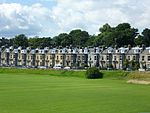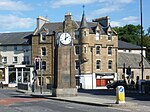Warriston Cemetery

Warriston Cemetery is a cemetery in Edinburgh. It lies in Warriston, one of the northern suburbs of Edinburgh, Scotland. It was built by the then newly-formed Edinburgh Cemetery Company, and occupies around 14 acres (5.7 ha) of land on a slightly sloping site. It contains many tens of thousands of graves, including notable Victorian and Edwardian figures, the most eminent being the physician Sir James Young Simpson. It is located on the north side of the Water of Leith, and has an impressive landscape; partly planned, partly unplanned due to recent neglect. It lies in the Inverleith Conservation Area and is also a designated Local Nature Conservation Site. The cemetery is protected as a Category A listed building.In July 2013 the Friends of Warriston Cemetery was inaugurated to reveal the heritage and to encourage appropriate biodiversity.
Excerpt from the Wikipedia article Warriston Cemetery (License: CC BY-SA 3.0, Authors, Images).Warriston Cemetery
Cemetery Road, City of Edinburgh Stockbridge/Inverleith
Geographical coordinates (GPS) Address Nearby Places Show on map
Geographical coordinates (GPS)
| Latitude | Longitude |
|---|---|
| N 55.969 ° | E -3.198 ° |
Address
Cemetery Road
Cemetery Road
EH7 4HW City of Edinburgh, Stockbridge/Inverleith
Scotland, United Kingdom
Open on Google Maps







